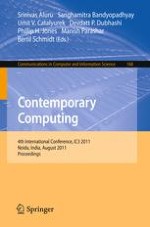2011 | Buch
Contemporary Computing
4th International Conference, IC3 2011, Noida, India, August 8-10, 2011. Proceedings
herausgegeben von: Srinivas Aluru, Sanghamitra Bandyopadhyay, Umit V. Catalyurek, Devdatt P. Dubhashi, Phillip H. Jones, Manish Parashar, Bertil Schmidt
Verlag: Springer Berlin Heidelberg
Buchreihe : Communications in Computer and Information Science
